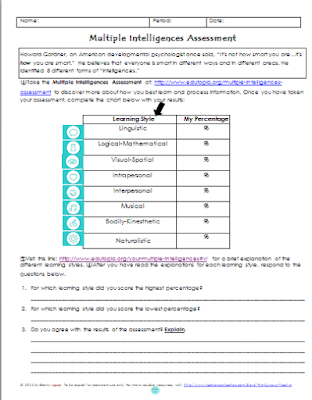Knowing Your Students' Learning Styles
One of the very first pieces of information I want to extract from my students is who they are as learners. Truth is, and perhaps too often, our students themselves don't know who they are as learners. Getting to know who our students are as learners from the very beginning will help the teacher design lessons, activities, differentiate, engage students, etc., etc.. As a result, I have created this super simple and easy handout for students to use as they navigate Edutopia's Multiple Intelligences Assessment.
Click the image to access and download this freebie!
This handout allows students to record their assessment results after taking a brief multiple intelligences assessment. It is important to remind students that just because they score high on a specific learning style, this does not mean that they can't or don't learn well in another learning style. The percentages simply indicate their learning style strengths and how they learn best and most comfortably.
On the same note, as educators, it is important to vary our delivery of content to appeal to the various learning styles. Additionally, if you have a class that is mostly Visual-Spatial, it does not make sense for most of your lessons to appeal only to Linguistic learners. In fact, most lessons contain elements of various learning styles, not just one. Lessons like these are the most appealing and tend to be very successful because it is appealing and accessible to students of all learning styles.
Please let me know how you will decide to utilize this resource in your classroom and whether or not it was successful if you already implemented it with your students. As soon as I use it with my own students in September I will surely post an update as well. Happy teaching...and remember to stay curious!




Comments
Post a Comment
Please post your thoughts, ideas, reactions!